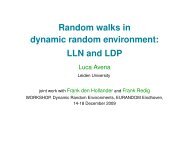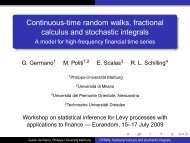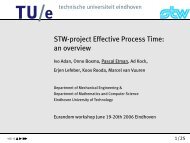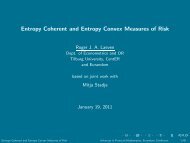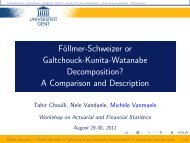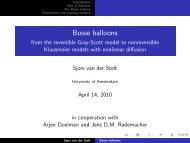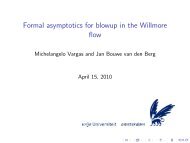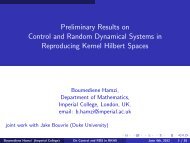EURANDOM
EURANDOM
EURANDOM
You also want an ePaper? Increase the reach of your titles
YUMPU automatically turns print PDFs into web optimized ePapers that Google loves.
October 29 & 30, 2009<br />
Asset Backed Securities (venue: EIB, Luxembourg)<br />
Organizers<br />
Guido Bichisao, European Investment Bank<br />
Henrik Jönsson, <strong>EURANDOM</strong><br />
Wim Schoutens, K.U. Leuven & <strong>EURANDOM</strong><br />
Karsten Sundermann, European Investment Bank<br />
Participants: 88<br />
A two day conference on securitization and asset-backed securities “Pricing and valuation of ABSs”<br />
was held at the European Investment Bank in Luxembourg, October 29 and 30, 2009, with 14 speakers<br />
from industry and academia. The conference attracted more than 80 participants from both industry<br />
and academia and can be viewed as a very successful event.<br />
The content of the first day was four longer (45 minutes) presentations on regulatory initiatives, rating<br />
methodology and valuation of ABSs. Marco Angheben, ESF, presented the most recent discussions with<br />
IOSCO, CESR, the European Commission and other regulators, central banks and policy makers surrounding<br />
the improvement of the current infrastructure for post-trade transparency. It also described<br />
the industry initiatives aimed at improving valuations, price discovery and transparency overall for<br />
structured finance products.<br />
Representatives from two of the major rating agencies, Moody’s and Standard and Poor’s, gave their<br />
views on the rating and valuation of ABSs. Benedicte Pfister (Moody’s) introduced Moody’s ABS rating<br />
methodology and models and presented in more detail the agency’s rating methodology for SME<br />
ABSs. The speaker also described how they have introduced measures (V score and Parameter sensitivity)<br />
to improve the reporting of the ratings sensitivity to underlying assumptions to investors. Peter<br />
Jones and James West (Standard and Poor’s) presented different valuation approaches in use at the<br />
present and the challenges to valuation that currently exist, i.e. data, analytic and cashflow requirements.<br />
Through a valuation assumption survey, where Standard and Poor’s asked market participants<br />
on their use of methods, models and assumptions for ABS valuation, the agency tries to create transparency<br />
of input assumptions used. The talk ended with a case study where the input assumption found<br />
in the survey was used to valuate an existing ABS deal.<br />
Laila Kollmorgen and Luke Mellor from Forseti Capital gave their view on mark to valuation techniques<br />
in an uncertain market. In the talk, the speakers compared the advantages and disadvantages<br />
of over-the-counter platforms and bespoke cashflow models and when it is appropriate to use the different<br />
approaches. The availability and quality of new issue and ongoing rep line data together with<br />
examples of good and not-so-good trustee reports as well as the valuation issues of credit dependent<br />
counterparties and their effects on the deal and how to determine the new levels of stressing was also<br />
touched upon during the presentation.<br />
The first day ended with a round table discussion chaired by Eric Péree, Chief Economist at EIB, and<br />
with a panel consisting of Anneli Peshkoff, Director Treasury, EIB; Wim Schoutens, Prof. Dr., KU Leuven<br />
& <strong>EURANDOM</strong>; Fabrice Susini, Board Member of ESF & Member of EFR; Michel Stubbe, Head of division<br />
Market Operations & Analysis, ECB; and Frederico Galizia, Head of Risk Management, EIF.<br />
The second day of the conference was devoted to nine 30 minutes talk. The first two talks in the morning<br />
were presented by non-industry participants, Henrik Jönsson (<strong>EURANDOM</strong>) and Jessica Cariboni (EC<br />
Joint Research Center). Henrik Jönsson discussed model risk and parameter uncertainty in the assessment<br />
of ABSs. Model risk refers to the fact that the outcome of the assessment of ABSs depends on<br />
which quantitative model is used to derive, for example, defaults in the asset pool backing the ABSs.<br />
The uncertainties in the parameters used as input to these models add to the uncertainty of the output<br />
of the assessment. The significance the model choice and parameter values have on the assessment of<br />
ABSs was shown in different examples.<br />
Quantitative sensitivity analysis as a tool for handling model choice and parameter sensitivity was presented<br />
by Jessica Cariboni. Jessica gave an introduction to quantitative sensitivity analysis and showed<br />
how sensitivity analysis can be used to assess the contributions of the inputs to the total uncertainty of<br />
the outcome of an analysis.<br />
The rest of the day contained presentations by representatives from different practitioner experts in<br />
the field. Let us mention two of these presentations, the one by Martin Scheicher, ECB, and Joao Garcia,<br />
Dexia. Martin Scheicher presented a research study on the pricing of subprime mortgage risk in<br />
good times and in bad, describing the use of regression analysis to establish the relationship between<br />
observed index returns and macroeconomic news as well as market-based proxies of default risk, interest<br />
rates, liquidity and risk appetite. Joao Garcia gave a colorful and dynamic presentation where he<br />
<strong>EURANDOM</strong> Annual Report 2009 30



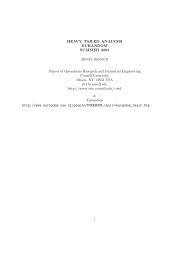
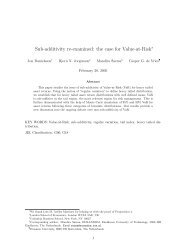
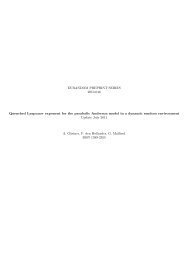
![The Contraction Method on C([0,1]) and Donsker's ... - Eurandom](https://img.yumpu.com/19554492/1/190x143/the-contraction-method-on-c01-and-donskers-eurandom.jpg?quality=85)
